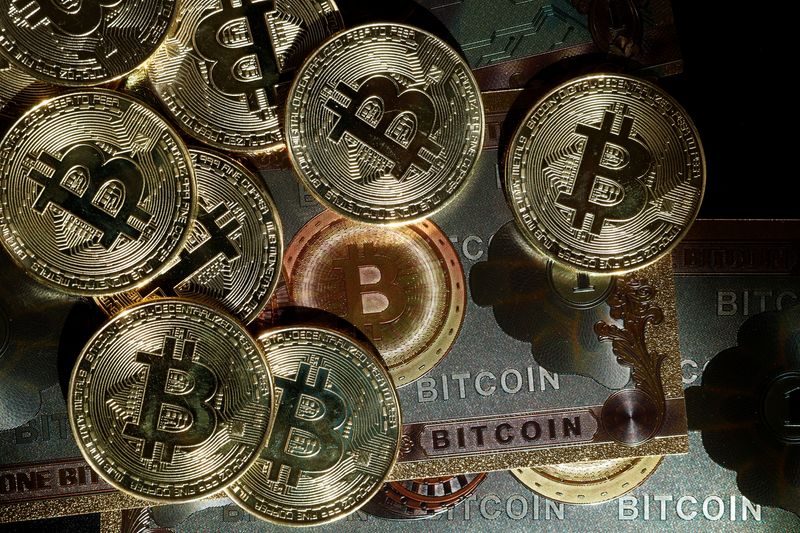
SINGAPORE (Reuters) -Bitcoin was the notable mover as it reached for one-month highs on Monday, sustaining its rally after the Federal Reserve’s super-sized rate cut last week, while the yen extended its decline in markets thinned by a Japanese holiday.
The dollar strengthened against the yen last week after policy meetings in both the United States and Japan, hitting its highest level in two weeks at 144.50 yen. It was around 144.16 on Monday.
The Bank of Japan (BOJ) left interest rates unchanged last week and indicated it was not in a hurry to hike them again. That decision, coming just days after the Fed’s 50 basis points (bps) rate cut, put a pause to the yen’s sharp gains this month. The currency is up 1.4% in September.
With Japan closed for Autumnal Equinox Day, the main driver of trade was expectations around further Fed rate cuts and the gains those have spurred in equities, commodity currencies and other risk assets.
Bitcoin was up 1.8% at $63,954, hovering near one-month highs. Ether was 3% higher at 2,660.30, near its highest since late August.
Chris Weston, head of research at Pepperstone, said the ‘goldilocks macro backdrop’ is the key factor driving the solid upside momentum.
“For now, this is a rally that is there for chasing. As we’ve seen over the years, when Bitcoin goes on a run, the trends can be powerful and FOMO can really get the crypto players fired up”
The Australian dollar was 0.4% higher at $0.68355, digesting its rise of more than 3% in less than two weeks.
The U.S. dollar index, which measures the greenback against six major currencies, was at 100.75, continuing to stay above the one-year low it hit last week. Euro was flat at $1.1165.
The Fed’s rate cut “appears to have calmed market fears of a U.S. recession”, Goldman Sachs said in a note. “Our G10 FX team expect a slight rebound for the U.S. dollar over the next 3 months, before easing again on a 6- and 12-month view.”
Fed futures traders have priced in 75 bps in rate cuts by the end of this year, and nearly 200 bps in cuts by December 2025 that will take the Fed’s policy rate by the end of next year to 2.75%, according to CME FedWatch.
The U.S. Treasury yield curve has been steepening after the Fed’s rate cut, and investors added to bets favoring a second outsized rate cut after Fed Governor Christopher Waller said on Friday he was worried inflation may soon be running substantially below the central bank’s 2% target.
Meanwhile, the majority of economists polled by Reuters anticipate two more 25 bps rate cuts at the Fed’s final two meetings this year.
In weekend news, U.S. House Republicans unveiled a three-month stopgap bill to avert a government shutdown.
For the yen, an upcoming ruling party vote later this week to choose a new prime minister makes the BOJ’s job challenging in the coming months. A snap election is seen as likely in late October.
Liberal Democratic Party frontrunners to replace outgoing Prime Minister Fumio Kishida have presented diverse views on monetary policy.
Sanae Takaichi – who would become the nation’s first female premier – is a reflationist who has accused the Bank of Japan of raising rates too soon. Shigeru Ishiba has said the central bank is “on the right policy track”, while Shinjiro Koizumi, son of charismatic ex-premier Junichiro Koizumi, has so far only said he will respect the BOJ’s independence.
The selection presents two-way risks for yen, Barclays analysts wrote on the weekend. “The main risk here is if Abenomics advocate Takaichi wins, this could pose headwinds to the BOJ’s policy-normalization plan and raise concerns about fiscal discipline,” they said.
That could lead to a steeper Japanese bond curve and downside pressure on the yen as investors pare expectations for another rate rise, they said.

The Bank of England kept rates unchanged on Thursday, with its governor saying the central bank had to be “careful not to cut too fast or by too much.”
The pound was little changed at $1.3315, staying near highs it hit on Friday after the release of strong British retail sales data.
This post is originally published on INVESTING.



